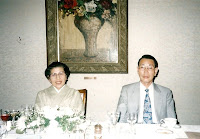 I lived in Tokyo, Japan for roughly 2 1/2 years from May 1993 - October 1995. During my first summer vacation I made arrangements to do a homestay for a couple of nights in Hiroshima, Japan. I wanted to be in Hiroshima on August 6 so that I could participate in the formal remembrance ceremony of the dropping of the first atomic bomb during WWII. When I got to Hiroshima, I called the young woman who was supposed to pick me up and take me to her home. The young woman came to the train station but then told me that she was unable to have me stay at her home. Instead she had arranged for me to stay with an older couple (see picture above). The older woman arrived at the station in a kimono and spoke limited English. I was very disappointed but I had nowhere else to stay so I went with her.
I lived in Tokyo, Japan for roughly 2 1/2 years from May 1993 - October 1995. During my first summer vacation I made arrangements to do a homestay for a couple of nights in Hiroshima, Japan. I wanted to be in Hiroshima on August 6 so that I could participate in the formal remembrance ceremony of the dropping of the first atomic bomb during WWII. When I got to Hiroshima, I called the young woman who was supposed to pick me up and take me to her home. The young woman came to the train station but then told me that she was unable to have me stay at her home. Instead she had arranged for me to stay with an older couple (see picture above). The older woman arrived at the station in a kimono and spoke limited English. I was very disappointed but I had nowhere else to stay so I went with her.It turned out that I was the luckiest person because my homestay host was a Sensei or teacher. She did not teach science, math, history, or even Japanese. She taught young women how to put on a kimono and it just so happened that she was holding class one of the nights that I stayed at her house.
Six of her students arrived precisely on time. My host introduced me to her students and then they began to dress. I watched in amazement. The hardest part by far was learning how to tie the obi, which is the very long piece of cloth that is wrapped around the waist and intricately tied and shaped in the back. The students checked each other's work and helped one another with the obi.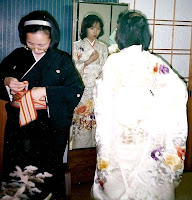


To my complete surprise it was now my turn. I could not believe it. I was absolutely thrilled. Not only would I have a chance to put on a kimono, but my host brought me a very special one to put on. This kimono was packed away in a box and perfectly stored. It was a formal wedding kimono.
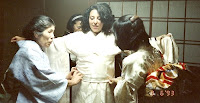 My host along with her 6 students began to dress me. First they put me in a large white garment with "wings" that almost touched the floor. This white wedding garment is called shiro-maku. Next a white obi was wrapped very, very tightly around my mid section and chest. It was so tight that my large chest became flat and I could not take full breaths in or out. A couple of the students worked on the special box/pillow-like obi tie on my back. Next the exquisite orange outer garment, which is called uchikake, was put on me.
My host along with her 6 students began to dress me. First they put me in a large white garment with "wings" that almost touched the floor. This white wedding garment is called shiro-maku. Next a white obi was wrapped very, very tightly around my mid section and chest. It was so tight that my large chest became flat and I could not take full breaths in or out. A couple of the students worked on the special box/pillow-like obi tie on my back. Next the exquisite orange outer garment, which is called uchikake, was put on me.
Once I had the proper clothing on, I had to complete the look with the right makeup and accessories. This meant tying my hair back, applying a white, white powder to my face and bright red lipstick to my lips.



 The most important accessory came next. From a second storage box my host pulled out a wig and gently placed gold jewelry in it. Then the wig was placed on my head.
The most important accessory came next. From a second storage box my host pulled out a wig and gently placed gold jewelry in it. Then the wig was placed on my head.
Lastly I put on a pair of special white socks that had only 1 slit between the big toe and the second toe. I then slipped into the special wooden shoes called geta.
Thanks to the hard work by my host and her six students, I had finally been transformed into a beautiful bride.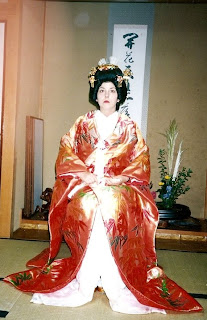
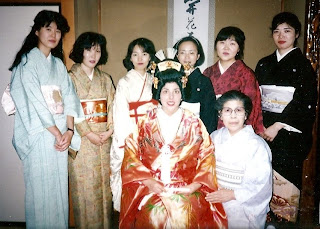
Not only did I get to put on a special wedding kimono with all the makeup and accessories, but I also tried on what I call a formal kimono and a casual kimono. The formal kimono or furisode is usually worn starting at the age of 20 and is made of silk. Its distinguishing characteristic is the long sleeves that go down almost to the floor. These long sleeves can hide money or notes that can be passed along to a romantic interest. The casual kimono or yukata has short sleeves and is often made of linen or cotton for the hot summer days.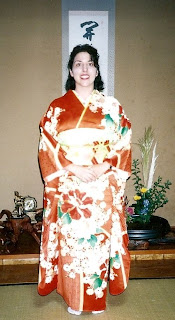

Although my initial homestay arrangement did not work out, I honestly could not have been more thrilled with my two hosts. While the Sensei and her students helped dress me, the Sensei's husband captured my fashion makeover on film. Sometimes the best experiences come from a last minute change in plans.
No comments:
Post a Comment